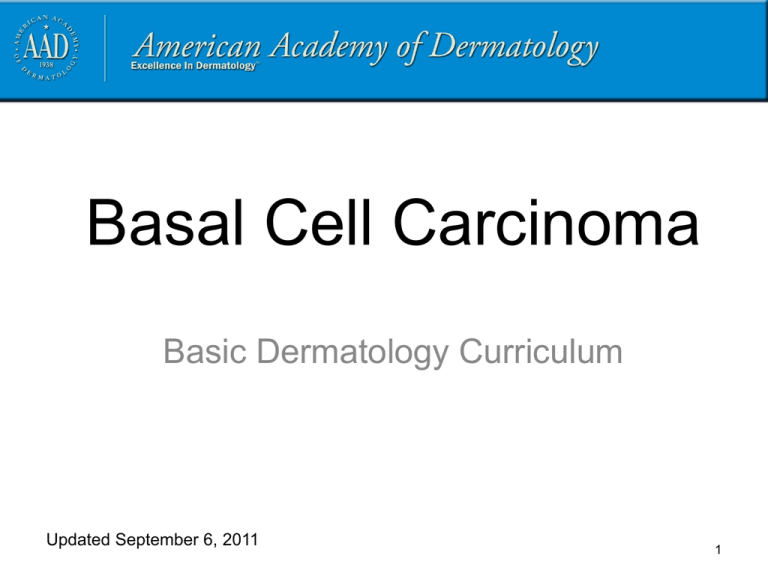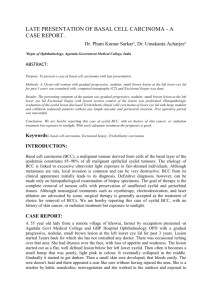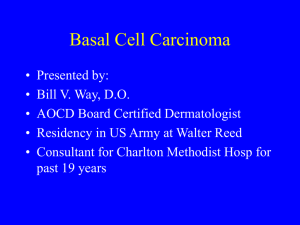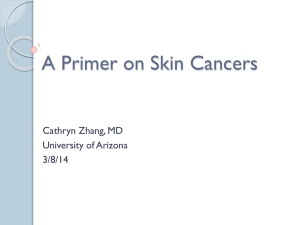Basal cell carcinoma - American Academy of Dermatology
advertisement

Basal Cell Carcinoma Basic Dermatology Curriculum Updated September 6, 2011 1 Module Instructions The following module contains a number of underlined terms which are hyperlinked to the dermatology glossary, an illustrated guide to clinical dermatology and dermatopathology. We encourage the learner to read all the hyperlinked information. 2 Goals and Objectives The purpose of this module is to help medical students develop a clinical approach to the evaluation and initial management of patients presenting with suspicious lesions. By completing this module, the learner will be able to: • Identify and describe the morphology of basal cell carcinoma • Formulate a differential diagnosis based on the patient’s history and physical findings • Refer patients with skin lesions suspicious for nonmelanoma skin cancer to dermatology 3 Clinical Case History Mr. Carter is a 62-yearold man who presents to your office with a growth by his right ear. He first noticed the growth about six months ago. He states that it has increased in size, but it otherwise does not bother him. 4 You learn more about Mr. Carter’s history… Past Medical History: • Extensive history of sun exposure, especially in childhood • Fair skin, usually burns, rarely tans • No history of skin cancer • No history of arsenic exposure or radiation • Hypertension, dyslipidemia, diabetes Medications: Aspirin, Insulin, Lisinopril, Simvastatin Family history: No history of skin cancer Social history: Married with 3 children. Health-related behaviors: 10-pack year smoking history; quit 10 years ago. No alcohol or drug use. 5 © 2009 A. Garg, MD How would you describe his facial growth? 6 © 2009 A. Garg, MD How would you describe his facial growth? Solitary, 5 mm pearly pink papule with telangiectasias 7 What is your differential diagnosis? After you have considered the differential diagnosis, go to the next slide for a list of possible diagnoses. 8 What is your differential diagnosis? • • • • • Basal cell carcinoma Intradermal nevus Sebaceous hyperplasia Seborrheic keratosis Squamous cell carcinoma 9 Evaluation What is your next step in evaluating this patient? a. b. c. d. e. Liquid nitrogen cryotherapy Reassurance with close follow-up Shave biopsy Surgical removal Topical antibiotics 10 Evaluation Answer: c What is your next step in evaluating this patient? a. Liquid nitrogen cryotherapy (cyrotherapy will not help diagnose the lesion) b. Reassurance with close follow-up (this is a suspicious lesion and should be biopsied) c. Shave biopsy d. Surgical removal (best to biopsy the growth in order to obtain histologic confirmation prior to surgical removal) e. Topical antibiotics (the lesion does not appear to have 11 a bacterial etiology) Shave Biopsy Reveals… • Rounded nests of “basaloid” cells • Peripheral palisading • Fibromyxoid stroma • Cleft formation 12 Ordering Pathology Note that the pathologist did not comment on the margins This is because we ordered a biopsy (for diagnosis) and not an excision (to confirm it is all out) Click here to watch a video on pathology requests 13 Shave Biopsy Click here to watch a video on local anesthesia Click here to watch a video on how to perform a shave biopsy 14 What is the diagnosis? a. b. c. d. e. Basal cell carcinoma Intradermal nevus Sebaceous hyperplasia Seborrheic keratosis Squamous cell carcinoma 15 What is the diagnosis? Answer: a a. Basal cell carcinoma b. Intradermal nevus (Pigmented or skin colored, appears early in life, and would not be expected to develop in this age group. Histologically, melanocytic nevi show nests of nevo-melanocytic cells in the dermis, without palisading or clefting) c. Sebaceous hyperplasia (Can have telangiectasias but tend to be yellowish or pink. Histologically, they show groups of normal looking sebaceous glands) d. Seborrheic keratosis (Verrucous (irregular surfaced) and NOT smooth. Also, they are not pearly and do not have surface telangiectasias. Histologically, they show thickend and verrucous epidermis with keratin cysts) e. Squamous cell carcinoma (Red nodule with keratin. Histologically, there are atypical keratinocytes in the epidermis and invading the dermis) 16 Management What is your next step in management? a. b. c. d. e. Shave biopsy Liquid nitrogen cryotherapy Reassurance with close follow-up Surgical removal Topical antibiotics 17 Management Answer: d What is your next step in management? a. Shave biopsy (You already have a diagnosis and there is no need for another biopsy) b. Liquid nitrogen cryotherapy (Liquid nitrogen cryotherapy is the treatment of choice for several benign and pre- cancerous skin lesions (e.g. actinic keratoses). It is not 1st-line treatment for BCC) c. Reassurance with close follow-up (Basal cell carcinomas are malignant and produce significant local tissue destruction. They must be treated early) d. Surgical removal (The treatment of choice for basal cell carcinoma is surgical excision. Alternatively, electrodesiccation and curettage or radiation therapy can be used) e. Topical antibiotics (Basal cell carcinoma is a tumor not an infection) 18 Biopsy vs. Excision How come we did not excise the whole lesion to begin with? It is best to biopsy the growth in order to obtain histologic confirmation prior to surgical removal, as biopsy may have revealed: • A benign growth, in which case excision would have been unnecessary • A tumor different from BCC that may have required a different management approach 19 At the follow-up visit 6 months later… Mr. Carter healed well following surgical removal. There is no evidence of tumor recurrence or new primary tumors. You counsel Mr. Carter on the importance of continued sun protection and regular self-skin exams, and you schedule him for routine full-skin exams every 6 months to a year in order to monitor for skin cancers. Now, let’s review Basal Cell Carcinoma 20 Basal cell carcinoma (BCC) Most common skin cancer • >1 million new cases per year in the US • Neoplasm arises from nonkeratinizing keratinocytes that originate in the basal layer of the epidermis Etiology • Ultraviolet radiation induces DNA damage • PTCH (tumor suppressor gene) mutation – Spontaneous/acquired mutations from UV-induced DNA damage 21 Basal cell carcinoma (BCC) Risk factors • Skin types I, II (fairer skin types)* • History of intense or prolonged ultraviolet light exposure • History of ionizing radiation exposure or arsenic ingestion • Immune suppression (transplant patients, systemic immunosuppressive medications) • Genetic conditions that increase skin cancer risk * BCC is still commonly seen in darker skin types 22 Classifying Skin Types The Fitzpatrick Skin Phototype Classification is used to classify skin based on the ability to burn and tan when challenged with UV radiation I. II. III. IV. V. VI. White skin, always burns, never tans White skin, always burns, minimal tan White skin, burns minimally, tans moderately and gradually Light brown skin, burns minimally, tans well Brown skin, rarely burns, tans deeply Dark brown/black skin, never burns, tans deeply Note: sunscreen is recommended for all skin types, including the darkest of skin 23 There are other clinical subtypes of BCC: 24 Nodular BCC Most common subtype Presents as a pearly papule or nodule with rolled border and telangiectasias Although any part of the body may be involved, the lesions are most frequently found on the head and neck 25 Superficial BCC Presents with features suggestive of BCC including a pink or translucent color, telangiectasia, and a slightly rolled border Morphology is a patch or a thin plaque, which may be scaly Differential diagnosis may include squamous cell carcinoma in situ or actinic keratosis 26 Ulcerated BCC Presents with features suggestive of BCC including a translucent color, telangiectasia, and a rolled border In addition, the growth is grossly or microscopically ulcerated, which often results in crusting over the growth 27 Pigmented BCC Presents with features typical of a BCC along with globules of dark pigment The differential diagnosis may include malignant melanoma 28 Morpheaform BCC Presents with features suggestive of BCC including a translucent color, telangiectasia, and a rolled border In addition, the plaque appears white and bound down or scar-like in areas 29 BCC: Treatment There are several surgical and non-surgical treatment options. The best option is selected after consideration of clinical and histologic features. To select the optimum therapy, refer to a dermatologist 30 BCC: Treatment Surgical Treatment Options: • • • • Curette and Desiccation Cryosurgery Excision with standard 3-4mm margins Mohs micrographic surgery – permits real time evaluation of tumor margins and consequent tissue conservation to minimize defect size Non-Surgical Treatment Options: • • • • Imiquimod cream – FDA approved for superficial BCC 5% fluorouracil cream for superficial BCC Photodynamic therapy for superficial BCC Radiation 31 Mohs Micrographic Surgery (MMS) MMS offers superior histologic analysis of tumor margins while permitting maximal conservation of tissue compared with standard surgical excision Recurrence rates tend to be lower with MMS compared to other modalities, including standard excision, curettage and desiccation, radiation, and cryotherapy Indications include: • Location: nose, ears, eyes, lips, scalp, hands • Aggressive histologic subtypes: infiltrative, sclerosing, morpheaform, or micronodular • Large tumors or tumors with indistinct clinical borders • Recurrent tumors 32 Mohs Micrographic Surgery Step 1: The roots of a skin cancer may extend beyond the visible portion of the tumor. If these roots are not removed, the cancer will recur. Step 2: The visible tumor is surgically removed. Step 3: A layer of skin is removed and divided into sections. The surgeon then color codes each of these sections with dyes and makes reference marks on the skin to show the source of these sections. A map of the surgical site is then drawn. Mohs Micrographic Surgery Step 4: The undersurface and edges of each section are microscopically examined for evidence of remaining cancer. Step 5: If cancer cells are found under the microscope, the surgeon marks their location onto the "map" and returns to the patient to remove another layer of skin - but only from precisely where the cancer cells remain. Step 6: The removal process stops when there is no longer any evidence of cancer remaining in the surgical site. BCC: Course & Prognosis BCC is locally invasive Metastasis is rare Patients with BCC are at risk for developing other non-melanoma and melanoma skin cancers They should have follow-up at regular intervals (e.g. every 6 months to 1 year) 35 Patient Education There are multiple resources to help educate patients about sun safety and skin cancer prevention, including: • American Academy of Dermatology: Skin Cancer Prevention • American Cancer Society: Skin Cancer Prevention and Early Detection The following slides are adapted from the AAD Be Sun Smart® program 36 Patient Education: Be Sun Smart® Generously apply a broad-spectrum, water-resistant sunscreen with a Sun Protection Factor (SPF) of 30 or more to all exposed skin. • “Broad-spectrum” provides protection from both UVA and UVB rays. • Reapply approximately every two hours, even on cloudy days, and after swimming or sweating. Wear protective clothing, such as a long-sleeved shirt, pants, a wide-brimmed hat, and sunglasses. Seek shade. • Remember that the sun's rays are strongest between 10 AM – 4PM. • If your shadow appears to be shorter than you are, seek shade. 37 Patient Education: Be Sun Smart® Use extra caution near water, snow, and sand because they reflect and intensify the damaging rays of the sun, which can increase your chances of a sunburn. Get vitamin D safely through a healthy diet that may include vitamin supplements. Don't seek the sun. Avoid tanning beds. Ultraviolet light from the sun and tanning beds can cause skin cancer and wrinkling. If you want to look tan, consider using a self-tanning product, but continue to use sunscreen with it. Check your birthday suit on your birthday. If you notice anything changing, growing, or bleeding on your skin, see a dermatologist. 38 How to perform a skin self-examination Examine your body front and back in the mirror, then look at the right and left sides with your arms raised. Look at the backs of your legs and feet, the spaces between your toes, and the soles of your feet. Bend elbows and look carefully at forearms, upper underarms, and palms. Examine the back of your neck and scalp with a hand mirror. Part hair for a closer look. 39 Take Home Points BCC is the most common skin cancer It is most common in the head and neck BCC is locally destructive but metastases are extremely rare Diagnosis is established by biopsy Treatment depends on clinical and histological features but is usually surgical Educate patients about skin cancer prevention 40 Acknowledgements This module was developed by the American Academy of Dermatology Medical Student Core Curriculum Workgroup from 2008-2012. Primary authors: Amit Garg, MD, FAAD; Lisa Nguyen, MD; Meera Mahalingam, MD. Contributor: Sarah D. Cipriano, MD, MPH. Peer reviewers: Timothy G. Berger, MD, FAAD; Patrick McCleskey, MD, FAAD; Carlos Garcia, MD; Isaac M. Neuhaus, MD, FAAD. Revisions: Sarah D. Cipriano, MD, MPH. Last revised September, 2011. Thank you to the American College of Mohs Surgery for providing images of the Mohs surgery process 41 References Carucci John A, Leffell David J, "Chapter 115. Basal Cell Carcinoma" (Chapter). Wolff K, Goldsmith LA, Katz SI, Gilchrest B, Paller AS, Leffell DJ: Fitzpatrick's Dermatology in General Medicine, 7e: http://www.accessmedicine.com/content.aspx?aID=2954299. Chartier TK. Treatment and prognosis of basal cell carcinoma. In: UpToDate, Basow, DS (Ed), UpToDate, Waltham, MA, 2011. James WD, Berger TG, Elston DM, “Chapter 29. Epidermal Nevi, Neoplasms, and Cysts” (chapter). Andrews’ Diseases of the Skin Clinical Dermatology. 11th ed. Philadelphia, Pa: Saunders Elsevier; 2011: 633-637. McGovern TW and Leffell DJ. Actinic Keratoses and Non-Melanoma Skin Cancer, Clinical Dermatologic Curriculum for Medical Students, http://www.aad.org. Neville JA, et al. Management of nonmelanoma skin cancer in 2007, Nat Clin Pract Oncol, 2007;4(8):462-9. Wolff K, Johnson RA, "Section 11. Precancerous Lesions and Cutaneous Carcinomas" (Chapter). Wolff K, Johnson RA: Fitzpatrick's Color Atlas & Synopsis of Clinical Dermatology, 6e: http://www.accessmedicine.com/content.aspx?aID=5186831. 42 Additional Resources Berger T, Hong J, Saeed S, Colaco S, Tsang M, Kasper R. The Web-Based Illustrated Clinical Dermatology Glossary. MedEdPORTAL; 2007. Available from: www.mededportal.org/publication/462 Nguyen L, Mahalingam M, Garg A. Dermatology Clinical Case Modules: 62Year-Old Man With a Facial Growth. MedEdPORTAL. 2010; Available from: http://services.aamc.org/30/mededportal/servlet/s/segment/mededportal/?subi d=7751 Nguyen L, Mahalingam M, Garg A. Dermatology Clinical Case Modules: 70Year-Old Man with a Red Crusty Bump on his Right Arm. MedEdPORTAL; 2010. Available from: http://services.aamc.org/30/mededportal/servlet/s/segment/mededportal/?subi d=8055 Nguyen L, Mahalingam M, Garg A. Dermatology Clinical Case Modules: 40year-old Woman with a Dark Mole. MedEdPORTAL; 2010. Available from: http://services.aamc.org/30/mededportal/servlet/s/segment/mededportal/?subi 43 d=8067











